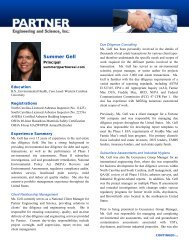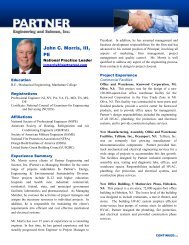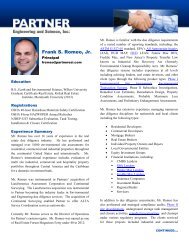Use of California Human Health Screening Levels (CHHSLs) in ...
Use of California Human Health Screening Levels (CHHSLs) in ...
Use of California Human Health Screening Levels (CHHSLs) in ...
Create successful ePaper yourself
Turn your PDF publications into a flip-book with our unique Google optimized e-Paper software.
Steps 4 - Determ<strong>in</strong>e the Desired Land <strong>Use</strong><strong>Screen<strong>in</strong>g</strong> levels for residential land use are generally appropriate for othersensitive uses <strong>of</strong> the property (e.g., day-care centers, hospitals, etc.). If prepar<strong>in</strong>ga DTSC PEA, residential land use <strong>CHHSLs</strong> should be used. For evaluation <strong>of</strong>commercial/<strong>in</strong>dustrial properties, it is highly recommended that site data becompared to <strong>CHHSLs</strong> for both unrestricted/residential andcommercial/<strong>in</strong>dustrial land use. Commercial/<strong>in</strong>dustrial <strong>CHHSLs</strong> should beused only under the oversight <strong>of</strong> a regulatory agency, as that agency will likelyrequire a land use covenant that restricts use <strong>of</strong> the property to these purposes.Steps 5 - Select <strong>CHHSLs</strong>Based on the actual or proposed land use, select the appropriate soil and/or soilgas <strong>CHHSLs</strong>. Replace <strong>CHHSLs</strong> with naturally occurr<strong>in</strong>g, backgroundconcentrations <strong>of</strong> chemicals <strong>of</strong> concern (e.g., arsenic) or laboratory methodreport<strong>in</strong>g levels if appropriate (see Sections 2.6 and 2.7).Step 6 - Compare Site Data To <strong>CHHSLs</strong>; calculate cumulative risks asnecessaryCompare site data to <strong>CHHSLs</strong> to identify areas where concentrations <strong>of</strong>contam<strong>in</strong>ants pose potential human health concerns. For sites where sample dataare limited and/or if prepar<strong>in</strong>g a DTSC PEA, compare the maximum-detectedconcentrations <strong>of</strong> chemicals <strong>of</strong> concern to the <strong>CHHSLs</strong>.For sites where an adequate number <strong>of</strong> data po<strong>in</strong>ts are available, statisticalmethods can be used to estimate site-specific exposure po<strong>in</strong>t concentrations. Theexposure po<strong>in</strong>t concentration is the lesser <strong>of</strong> the maximum-detected concentrationand the 95% upper confidence limit (UCL) <strong>of</strong> the arithmetic mean <strong>of</strong> sample data(Cal/EPA 1996a). The USEPA guidance document Calculat<strong>in</strong>g UpperConfidence Limits for Exposure Po<strong>in</strong>t Concentrations at Hazardous Waste Sitesrecommends evaluat<strong>in</strong>g the distribution <strong>of</strong> the data and choos<strong>in</strong>g the best UCLestimate for the data set (USEPA 2002). Guidance for the estimation <strong>of</strong> exposurepo<strong>in</strong>t concentrations, use <strong>of</strong> “non-detect” data, and other issues is also provided <strong>in</strong>the Cal/EPA documents Prelim<strong>in</strong>ary Endangerment Assessment GuidanceManual (Cal/EPA 1994b), Supplemental Guidance For <strong>Human</strong> <strong>Health</strong>Multimedia Risk Assessments <strong>of</strong> Hazardous Waste Sites and Permitted Facilities(Cal/EPA 1996a), among other sources. As discussed <strong>in</strong> these documents, sampledata collected outside <strong>of</strong> impacted areas should generally not be <strong>in</strong>cluded <strong>in</strong>estimation <strong>of</strong> exposure po<strong>in</strong>t concentrations.January 20052-4CHHSLS















